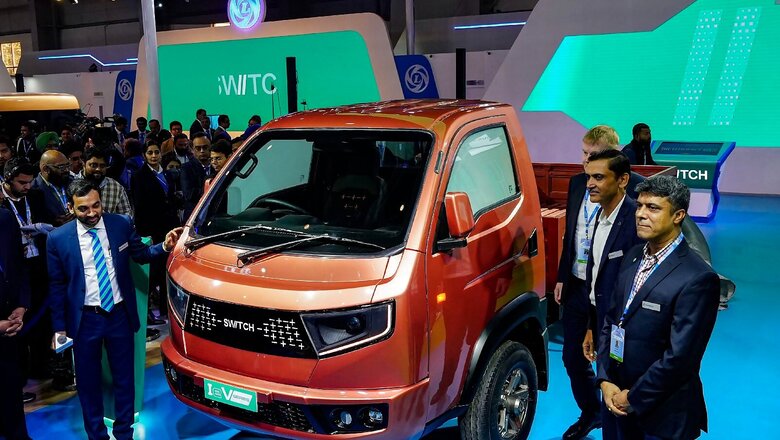
views
Electric vehicles are stealing the limelight at this year’s Auto Expo with big to small auto players showcasing their new EV models, highlighting their commitment to invest in a sustainable future and support the government’s vision to create a nationwide EV ecosystem.
At the Motor Show, News18 spoke to a few exhibitors, who launched their own products, and all of them agreed to align with the Centre’s vision of electrifying the roads and the target to reach net zero by 2070.
Union Commerce Minister Piyush Goyal had recently asked the secretaries in the Road Transport ministry to prepare a joint action plan for the electrification of all public transport vehicles in the country.
Uday Narang, founder and chairman of Omega Seiki Mobility, which exhibited the new SCV OSM M1KA 1.0, India’s first IOT Integrated, four-door with cosmic roof electric passenger vehicles MUSE and air-conditioned electric passenger vehicle ‘KRAZE’ at the expo, told News18 that they are looking forward to being a part of this idea of electrifying the public transport vehicles.
“Our products are made specifically for this. We have built the technology, product, range and quality specifically keeping this in mind, and mainly for the growth of the country, as well as to contribute to the EV ecosystem establishment,” said Narang.
To make this ecosystem, he believes that it is important to touch every part of the country, not just a few states. “We need to move it to the North East, Madhya Pradesh and Bihar. We need to across the country; from Jammu and Kashmir to Kanyakumari, EVs should reach everywhere.”
The industry insider said Omega Seiki Mobility will be a big part of that mission as the company has the vision to extend the ecosystem to rural India as well since the majority of the population lives there. Narang also talked about the government’s recent initiatives and said that the Centre has been working on the policies and ecosystem development regulations.
“We would need the government’s support for the ecosystem but we will also do our part to create the ecosystem,” he added.
Other exhibitors at the expo also agree to the fact that to establish a vast ecosystem in India, all the states should come up with plans, while companies will do their part to reach the population. News18 also learnt from the people in the arena that since with time and technology the digital divide is reducing, information is now getting more accessible to the rural India population which is now quite aware of the EV market.
Anant Badjatya, CEO of SUN Mobility, which partnered with Hero Electric to deploy electric two-wheelers integrated with the latter’s smart-swappable battery technology, said that apart from Uttar Pradesh and Delhi, which are the top leaders in EV adoption, the ecosystem would do well in Andhra Pradesh, Telangana, Gujrat and West Bengal.
“Because of the terrain in the North East zone, an EV ecosystem out there would take some time but companies like Tera Motors are already present in that region. I think along with West Bengal, North East, which has enough market potential, will also start to adopt EVs and we have to target this region to make it happen,” he added.
Charge or Swap
When it comes to the overall ecosystem development, charging station availability has been a constant concern for potential buyers. At the expo, there are several charging ports on display and interested people received a brief explanation from the companies on how to use these charging points. For example, MG Motor showcased six different ways of charging the vehicles.
But some claim that swappable batteries, an alternative option to charging, are better in many ways.
One of the exhibitors while explaining this alternative option for EVs claimed that with battery swapping, users can exchange the EV battery for a fully charged one, eliminating the need for long periods of charging their EV.
Though whether to charge or swap is obviously dependent on the consumer’s specific requirements and using a charger is the most widespread method, some believe that battery swapping can make EVs safer and cut costs.
It was said that battery swapping reduces the upfront costs, cuts refuelling time from five to eight hours to a few minutes and addresses the major issue of range anxiety.
The CEO of Sun Mobility, which launched SwapX, a fully automated battery-swapping solution and S2.1, a lightweight, smart, and robust smart battery at Auto Expo 2023, told News18: “When you use a swappable battery instead of a fixed battery (which is heavier, and weights more than 3 tons), the weight of a bus, for example, reduces by almost 2.7 tons which helps to increase the capacity of the vehicle to have more passengers.”
“We can see the possibility in the case of passenger buses as we have done the pilot and it was a success. We also see the possibility in the usage of swappable battery in trucks,” said Badjatya, adding that setting up swappable battery stations is also quite easy and one station can have at least 70 to 80 batteries.
“Setting up the swap stations can begin with extremely busy roads like Delhi-Jaipur, Bengaluru-Chennai and Bengaluru-Hyderabad routes. On these frequently used routes, such stations can be set up on both sides of the road and it doesn’t take much infrastructure,” added Badjatya.
However, he appreciated Piyush Goyal’s idea of EVs in public transport and said that the electric trucks in the public sector, used to transport goods, can benefit from the swappable battery system.
According to Badjatya, “When someone buys a truck with fixed battery worth Rs 30 lakh or Rs 1 crore, it is natural that if a better battery truck launches, they might think that the latest version is better. But when it comes to the vehicles with the swappable option, they don’t have to bother about all these, because they have the swap system in place.”
While talking about the overall ecosystem, he said that in the last four years, things have changed in India in terms of adopting EVs and creating an ecosystem. He also mentioned that mass electrification would take a maximum of seven-eight years as the original equipment manufacturer or OEMs are making investments in the EV ecosystem instead of an internal combustion engine or ICE.
“The biggest issue has been the dependency on fossil fuel and the import of oil, which is our biggest cash-out. So, considering all these issues, OEMs and the government has been pushing EVs and in a few years it will be all about only EVs,” he added.
Read all the Latest Auto News here




















Comments
0 comment